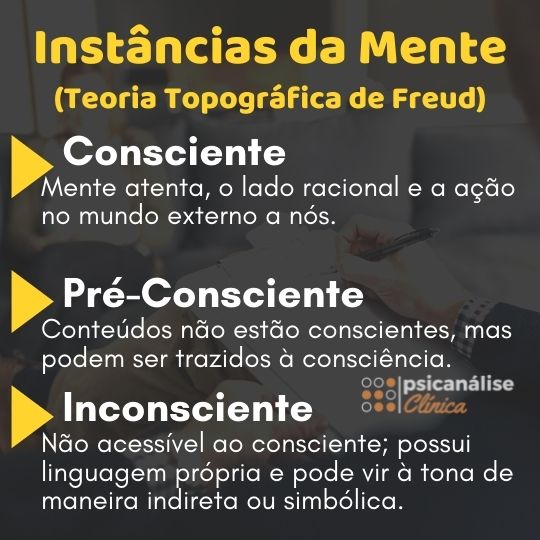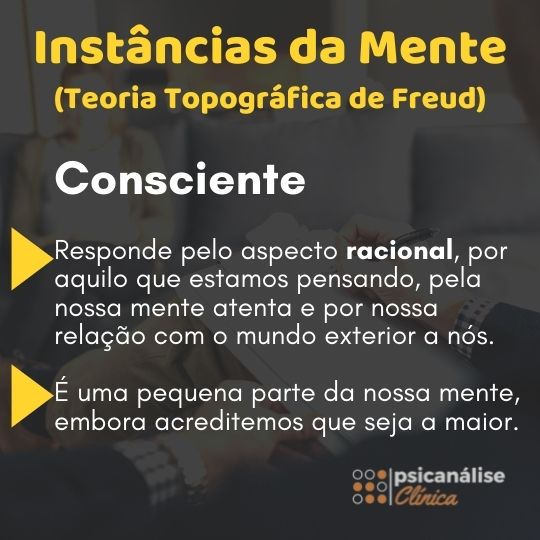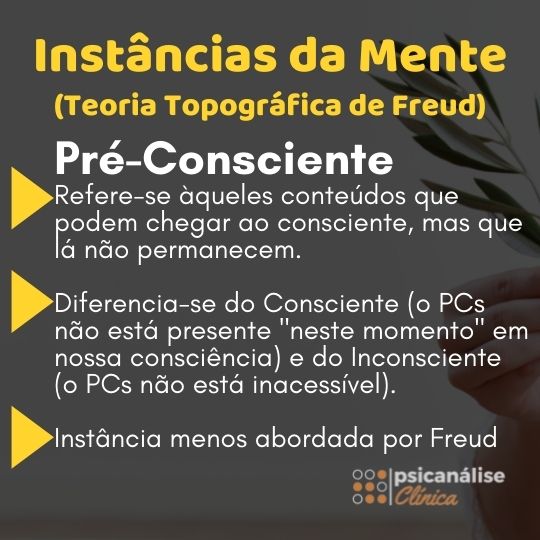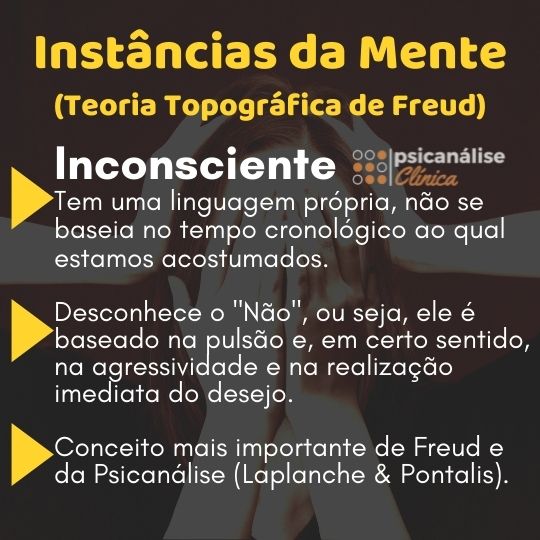Table of contents
In the previous post, we were concerned with the concept of the unconscious in psychoanalysis. As we saw, it represents the largest portion of the human mind. Let us now look at related definitions of Conscious, Preconscious, and Unconscious. So, read our post to learn more about this very important subject.
Understand these parts of the human mind
For a long time, it was believed that the human mind was composed only of the conscious. That is, the person was thought of as an animal with full capacity to manage. According to:
- your wish;
- the social rules;
- your emotions;
- finally, his convictions.
But if a person is able to perceive and control the content of his mind, how can one explain psychosomatic illnesses? Or those memories that surface randomly?
According to Freud, what are the instances of the human mind?
Freud says that there is no discontinuity in the human mind, so there are no coincidences in our little everyday mistakes. When we change a name, for example, we are not committing random accidents.
To find the hidden relationships between conscious acts, Freud operates a topographical division of the mind, in which he delineates three mental levels or mental instances:
- conscious ;
- pre-conscious ;
- unconscious .
It is important to note that Freud did not advocate where in the mind each instance was located. Although this theory of Freud's was called topographical theory (or Freudian First Topic) The sense of topos relates to virtual or functional places, that is, the parts of the mind as performing certain roles.

What is Consciousness
The level conscious is nothing more than everything we are aware of in the moment, in the now. It would correspond to the smallest part of the human mind. In it is everything we can intentionally perceive and access.
Another important aspect is that the conscious functions according to social rules, respecting time and space. This means that it is through it that our relationship with the external world takes place.
The conscious level would be our ability to perceive and control our mental content. Only that part of our mental content present at the conscious level can be perceived and controlled by us.
In short, the Conscious accounts for the rational aspect, for what we are thinking, for our attentive mind, and for our relationship with the world outside of us. It is a small part of our mind, although we believe it is the largest.

What is Pre-consciousness
O pre-conscious is often called the "subconscious", but it is important to note that Freud did not use the term subconscious. The preconscious refers to those contents that may reach the conscious, but do not remain there.
The contents are information that we don't think about, but that are necessary for the conscious to do its functions. Our address, second names, friends' names, phone numbers, and so on.
It is also important to remember that, although it is called Pre-conscious, this mental level belongs to the unconscious. We can think of the pre-conscious as something that lies between the unconscious and the conscious, filtering the information that will pass from one level to the other.
Can you remember a fact from your childhood when you had a physical injury? Example: you fell off your bike, scraped your knee, broke a bone? So this could be an example of a fact that was at the pre-conscious level until you now bring it to the surface of consciousness.
I want information to enroll in the Psychoanalysis Course .
It is possible to say that the preconscious is not on a repressed or interdicted level, as the facts of the unconscious that are of most interest to psychoanalysis usually are.
Compared to the other levels (conscious and unconscious), the preconscious is the least addressed by Freud and, we can say, the least relevant to his theory.

What is Unconscious
In other materials, we have already taken a closer look at freudian concept of the unconscious Let's try, however, to talk a little more about our understanding of its meaning. Unconscious refers to all that mental content that is not available to the person at any given time.
Read Also: History of Psychoanalysis: How the Theory AroseIt is not only the largest slice of our mind, but also, for Freud, the most important. Almost all the memories we believe are lost forever, all the forgotten names, the feelings we ignore are in our unconscious.
That's right: from the earliest childhood, the first friends, the first understandings: everything is stored. But would it be possible to access it? Would it be possible to relive these memories? Accessing these memories is possible - not in their totality, but of some slices. This access often happens through dreams, the failed acts, and psychoanalytic therapy.
For Freud, the most interesting reflection about the unconscious is to see it with a portion of our mind that is not accessible by clear memory, that is not easy (maybe not even possible) to convert into clear words.
We can say that the unconscious has its own language, it is not based on the chronological time we are used to. Also, it is possible to say that the unconscious does not see the "No", that is, it is based on the drive and, in a certain sense, on aggressiveness and the immediate fulfillment of desire.
Therefore, at the individual level the mind can create barriers and interdictions, called settlements or recalcitrance Or, at the social level, to create laws and moral rules and convert this energy into activities that are "useful" to society, such as work and art, a process that Freud will call sublimation .

Understanding more about the Unconscious
Moreover, it is in the unconscious that the so-called life drive and death drive That would be those elements that are in us, such as the sexual impulse or the destructive impulse. Life in society requires that some behaviors be repressed, so they get stuck in the unconscious.
The unconscious has its own laws, and is atemporal in that it does not have the notions of time and space. In other words, the unconscious does not know the order of facts, in experiences or memories. Moreover, it is the main responsible for the formation of our personality.
I want information to enroll in the Psychoanalysis Course .
Are you enjoying our post? Then, we invite you to comment below on what you think, and at the end of the text, we have a special invitation for you!
Final Thoughts on the Conscious, Unconscious and Preconscious
In analyzing phenomena, Freud saw the impossibility that the human mind has only a small conscious part. With the need to find the darkest links between incoherent behaviors, he says there are more mental levels. Moreover, people have no control or access to these places.
See_also: Darkness phobia (Nicthophobia): symptoms and treatments- The largest dimension of our mind is Unconscious The unconscious is the largest and most important part of the human mind. It contains our drives, our memories, our repressed desires, the origin of symptoms and disorders, as well as the essential elements that form the human mind.our personality.
- In turn, the Conscious is all the mental material accessible to the person at that moment; it accounts for our rational side and the way we rationalize the world theoretically external to our psyche.
- Already the Pre-conscious is a link between the conscious and the unconscious; of the three levels, this was the least relevant to the debates of psychoanalysis. The preconscious has important information for our day to day life, but we only access it when something makes us seek it.
Finally, it is important to know that this Freudian model does not delimit three closed and immutable compartments of our mind. It is necessary to know the existence of a certain fluidity between them. Conscious contents can become painful and be repressed by us, becoming part of the unconscious.
Just as a certain obscure memory can come to light through a dream or a psychoanalysis session that illuminates it. In fact, these areas of our mind are not simply part of the human mind, but speak to the condition and function of our psychic contents.
By the way, if you liked the post about conscious, preconscious and unconscious We invite you to get to know our online psychoanalysis course. Through it, you will have access to great content and have good teachers, so don't waste time! Sign up now and start today.
Read Also: Freud and his study on cocaine